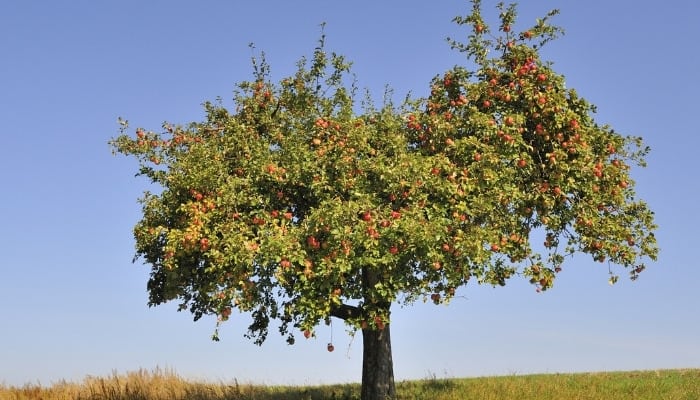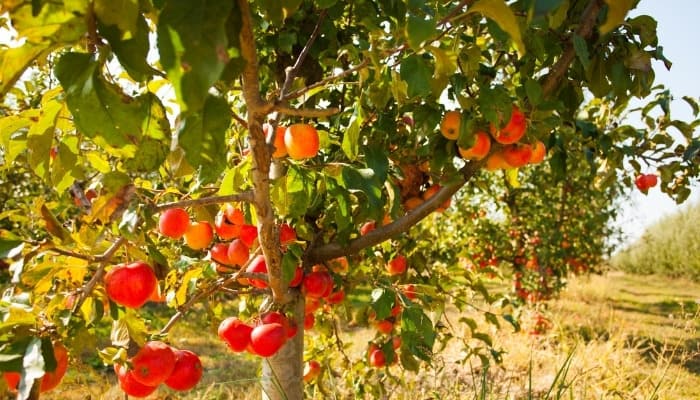Similar to owning a pet, there is a price associated with growing a tree. This cost is even higher for fruit trees, such as apple trees.
I’m not just talking about the upfront price of purchasing the apple tree or sapling. There are long-term costs related to fertilizer, equipment, and pesticides among others.
How much do apple trees cost? The cost of purchasing an apple tree ranges from $25 to $150+. That price varies depending on the variety and size of the tree. Long term costs include tools, food and supplements, pesticides and fungicides, all of which may cost several hundred dollars or more per year.
Once you have calculated a budget for your apple tree, you’ll need to double it because you’ll need two apple trees in your garden to ensure they get pollinated and produce a good yield, unless you opt for a self-pollinating variety.
So how would you go about calculating the cost of growing an apple tree? Read on to get a clear idea of the prices, costs, and hidden fees that come with growing an apple tree.
Price of Apple Trees
The price tag on the apple tree in your local nursery doesn’t often paint a good picture of how much caring for the tree will cost you annually.
Long-term care of the tree usually requires more spending, not to mention the time and effort you’ll put into making sure the tree is healthy and thriving.
Moreover, not all apple trees have the same initial price. Some varieties can be quite expensive.
Factors That Influence the Price of an Apple Tree
Many factors impact the price of an apple tree. Perhaps the most important factor is the apple variety you’re looking for.
Hybrids and cultivars such as Anna or Arkansas Black can be more expensive than more common apple species such as Gala or Granny Smith.
Another factor is whether you’re buying from a local nursery or from an online shop.
The local nursery is often more expensive, especially if they’re resellers, not growers.
A third factor is the size and age of the apple tree itself. A 2-foot apple tree will usually be cheaper than a 6-foot one. Bare-root trees typically cost less than potted ones.
Average Price of Potted Apple Trees
Potted apple trees are often young and small in size. They come in pots, which means their root system hasn’t fully developed yet.
A young apple tree is more vulnerable to pests and diseases than one with a full root ball. The average price of the potted apple tree ranges from $20 to $45.
Buying two potted trees (you will need two trees in close proximity to pollinate each other) can cost you less than $100, but that depends on the variety you’re purchasing.
Natural apple species are cheaper than heirloom cultivars.
Average Price of Bare-Root Apple Trees
You can get a good deal with a bare root apple tree that’s at least 2 years old. Such a tree has a fully developed root system and is ready to establish once you plant it in the garden.
Surprisingly, the average price of bare root apple trees is around $35 at local nurseries and online stores. That means you’re saving yourself the aggregate cost of 2 years worth of caring for the tree.
Real-World Prices of Popular Apple Tree Varieties
Here are 2 of my favorite places to shop for apple trees online:
Associated Cost of Apple Trees
The above prices of trees are quite deceptive because these price tags represent a small fraction of the actual cost of growing an apple tree.
There’s long-term care and equipment you’ll need to make sure the apple tree will be productive. Here’s a list of the average cost of growing two apple trees in your garden.
- Two apple trees: About $75
- 10-foot ladder for training and pruning: $130
- Lopper for pruning: $25
- Hand shears for pruning: $25
- Hand saw for pruning: $30
- Sprayer: $25
- Fertilizer: $35
- Pruning and training work: $20 an hour for labor
- Pesticides and sprays: $45
Keep in mind that, apart from the tools, these are recurring expenses every year.
The first year will usually be the most costly since you’ll be buying new tools, but all subsequent years will average about $200 give or take.
If the tree gets infected with a disease, that would add to your annual bill.
Considerations Before Purchasing an Apple Tree

Before you purchase your first apple tree, you need to do your due diligence.
Buying a tree that is not suitable for your particular Growing Zone or microclimate can be a recipe for failure, so make sure you go through the following checklist first.
Grow Zone
Apple trees come in different species, varieties, and cultivars. As expected, not all of these varieties have the same hardiness levels.
Before buying the apple tree, check if it’s labeled as hardy or long season.
A hardy apple tree can tolerate cold USDA Zones between 3 and 5. A long-season apple tree is more suitable for Zones 5 to 8.
Location
An apple tree needs an open space area that allows it to grow and spread and ensures enough air circulation.
More importantly, the spot should get at least 6 hours of full sunlight during the growing season.
Chilling Hours
On average, your apple tree needs between 500 and 1,000 chilling hours. Once the temperature drops below 45℉, you can start timing your chilling hours.
Check your Zone and the number of chilling hours your apple variety needs.
Cross-Pollination
To be on the safe side, you will need at least two apple trees growing within 50 feet of each other.
The majority of apple trees are not self-pollinating, so make sure you have enough space and resources for two or more apple trees.
Related Questions:
How Long Do Apple Trees Live?
Apple trees come in two broad classifications. The first is regular apple trees, which can live up to 50 years. They will stay productive for the big part of that long life.
The other type is dwarf apple trees. They have a shorter lifespan of 25 years at most.
How Far Apart To Plant Apple Trees?
When spacing your apple trees, consider the width of the canopy of the tree itself. Normal apple trees would need between 30 to 35 feet of space to grow and spread.
Dwarf apple trees will naturally need about half that space. You can plant them 15 feet apart without worrying about the roots getting overcompetitive or entangled.
Conclusion
An apple tree can be quite an investment if you plan to grow it in your garden. You’ll need two apple trees to pollinate each other, and make sure the apple variety is suited to your Growing Zone.
Related costs will stabilize after the first year, but on average, you can expect to fork out between $200 to $250 each year until the tree starts to produce apples.

